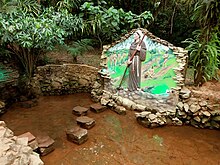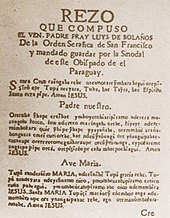Luis de Bolaños
Luis de Bolaños (* ≈ 1550 ? In Marchena ; † October 11, 1629 in Buenos Aires ) was a Franciscan who came to America in 1572 and initiated the reductions in Paraguay . He founded several cities and wrote the first grammar, the first dictionary and the first catechism in the Guaraní Indian language .
The early years
Luis de Bolaños was born in Marchena (Seville province) around 1550 and joined the Franciscan convent of Santa Eulalia near his native city at a young age . He began his ecclesiastical studies and was ordained a deacon . When the Franciscan Alonso de San Buenaventura visited the convent to look for missionaries for America, Bolaños joined the group in 1572 without completing his training as a priest. After a seven month long crossing, he arrived on the Brazilian coast. He accompanied Juan Ortiz de Zárate's expedition and reached Asunción on February 8, 1575 , where he began his missionary work.
Invention of reductions
For ten years he worked tirelessly alongside Alonso de San Buenaventura and was ordained a priest in 1585 by the Dominican Bishop Alonso Guerra. One of the main difficulties faced by the Franciscans in their missionary work in Latin America was the nomadic life of the indigenous people. In order to overcome this obstacle, Bolaños invented the reductions , permanent settlements in which the indigenous people who previously lived scattered in the jungle settled, the first step towards civilization. There he taught them not only Christian doctrine and reading and writing, but also farming, cattle breeding and, above all, craft activities. He also achieved pacification and the demographic stability of the Guaraní . The first reduction settlement was Altos in Paraguay , which he founded in 1580. This was followed by Ypané , Guarambaré , Atyrá , Tobatí , Itá , Yaguarón and Caazapá in Paraguay and Itatí and Baradero in Argentina . In Caazapá , Bolaños is particularly venerated because he is said to have performed a miracle there. The reductions founded by him and other Franciscans were later adopted by the Jesuits .
Creation of the grammar, dictionary and catechism of the Guaraní
Another difficulty the missionaries encountered in their work was the language barrier. The natives spoke and understood only Guarani. After Bolaños learned this language, which he mastered, he began to compose a grammar and dictionary of the Guaraní, which would be of great use to the missionaries who followed. Together with the Franciscan Gabriel de la Anunciación , he also translated the Catechism of Lima from 1583 into Guaraní. At the Synod of Asunción (1603), the Catechism of Bolaños was declared to be unique and compulsory for the entire Río de la Plata region. It was used in the Franciscan and Jesuit reductions until the 18th century.
The last few years
In 1618 he retired to the San Francisco Monastery of Buenos Aires , where he died on October 11, 1629. His remains remained in the monastery until 1979 when they were brought to the San Francisco Church of Asunción in a marble urn. In 2007, Bolaños' urn was carried through Caazapá in a procession to mark the 400th anniversary of the founding of the city .
Web links
- Luis de Bolaños ENCICLOPEDIA FRANCISCANA (Spanish)
- Luis de Bolaños pueblosoriginarios.com (Spanish)
- Luis de Bolaños (PDF) Universidad de Alicante (Spanish)
- Historia del Paraguay Ignacio Talesca (Spanish)
- Presencia franciscana en el Paraguay (1538-1824) Margarita Durán Estrago (Spanish)
- The Demographics of Colonization in Paraguay Guarani Linguistics in the 21st Century, p. 149 (English)
| personal data | |
|---|---|
| SURNAME | Bolaños, Luis de |
| BRIEF DESCRIPTION | Franciscan who came to America in 1572 and initiated the reductions in Paraguay |
| DATE OF BIRTH | 1550 |
| PLACE OF BIRTH | Marchena |
| DATE OF DEATH | October 11, 1629 |
| Place of death | Buenos Aires |

